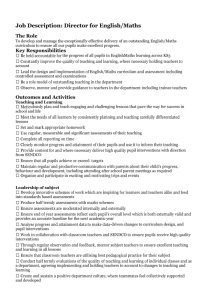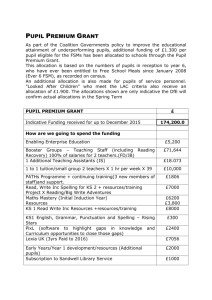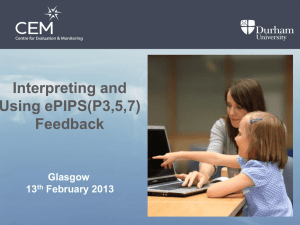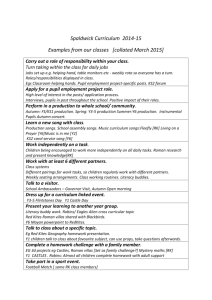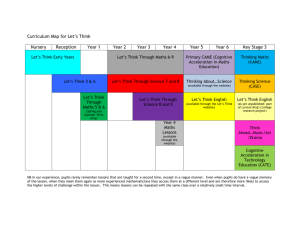Cognitive style in Mathematics
advertisement
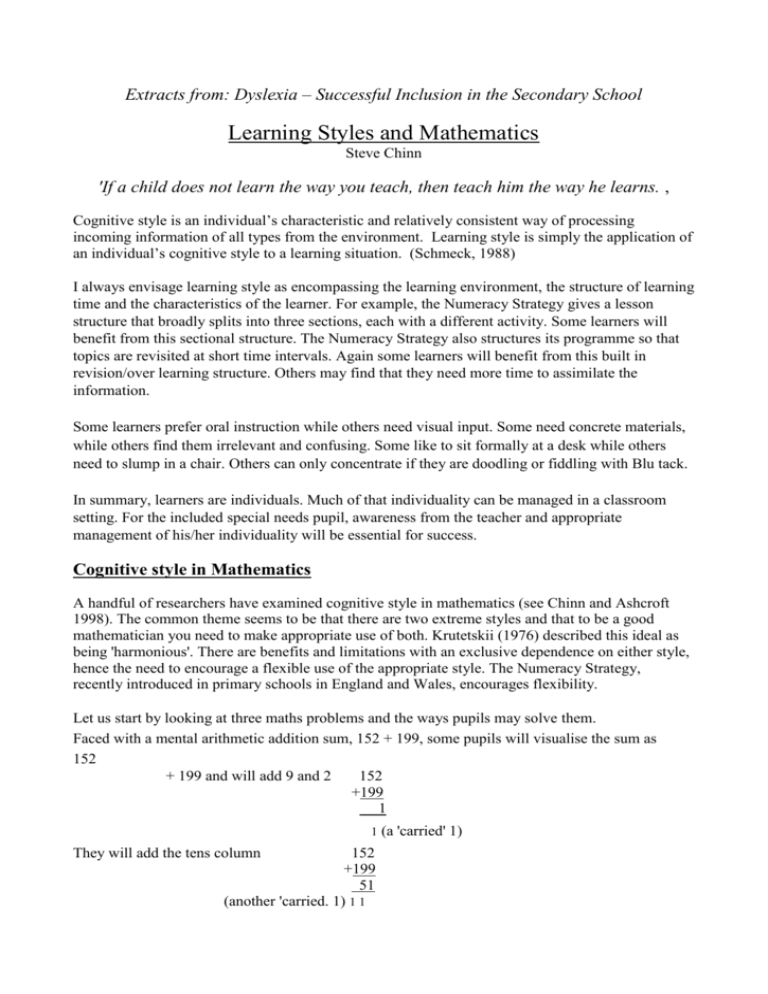
Extracts from: Dyslexia – Successful Inclusion in the Secondary School
Learning Styles and Mathematics
Steve Chinn
'If a child does not learn the way you teach, then teach him the way he learns. ,
Cognitive style is an individual’s characteristic and relatively consistent way of processing
incoming information of all types from the environment. Learning style is simply the application of
an individual’s cognitive style to a learning situation. (Schmeck, 1988)
I always envisage learning style as encompassing the learning environment, the structure of learning
time and the characteristics of the learner. For example, the Numeracy Strategy gives a lesson
structure that broadly splits into three sections, each with a different activity. Some learners will
benefit from this sectional structure. The Numeracy Strategy also structures its programme so that
topics are revisited at short time intervals. Again some learners will benefit from this built in
revision/over learning structure. Others may find that they need more time to assimilate the
information.
Some learners prefer oral instruction while others need visual input. Some need concrete materials,
while others find them irrelevant and confusing. Some like to sit formally at a desk while others
need to slump in a chair. Others can only concentrate if they are doodling or fiddling with Blu tack.
In summary, learners are individuals. Much of that individuality can be managed in a classroom
setting. For the included special needs pupil, awareness from the teacher and appropriate
management of his/her individuality will be essential for success.
Cognitive style in Mathematics
A handful of researchers have examined cognitive style in mathematics (see Chinn and Ashcroft
1998). The common theme seems to be that there are two extreme styles and that to be a good
mathematician you need to make appropriate use of both. Krutetskii (1976) described this ideal as
being 'harmonious'. There are benefits and limitations with an exclusive dependence on either style,
hence the need to encourage a flexible use of the appropriate style. The Numeracy Strategy,
recently introduced in primary schools in England and Wales, encourages flexibility.
Let us start by looking at three maths problems and the ways pupils may solve them.
Faced with a mental arithmetic addition sum, 152 + 199, some pupils will visualise the sum as
152
+ 199 and will add 9 and 2
152
+199
1
1
They will add the tens column
152
+199
51
(another 'carried. 1) 1 1
(a 'carried' 1)
and finally the hundreds column
152
+199
351
This has generated an answer of 351 , but in the reverse order, 1 then 5, then 3.
Faced with the same sum, 152 + 199, another pupil will add 152 + 200 to obtain 352, and then
subtract 1 to reach a final answer of 351.
A pupil is told to 'find' w if w + 3 = 10 so he remembers his teacher's instructions and writes
w = 10 - 3
w=7
Another pupil looks at the equation and just writes w = 7.
A pupil is asked to find which stall at a fair raises £90, if the total raised is £500 and
tombola takes 34%
books takes 11 %
cakes takes 23%
spinner takes 18%
crafts takes 14% of the total.
So he methodically calculates 34 x £500 = £170
100
11 x £500 = £55
100
etc…
A classmate looks at the same question and writes £90. The teacher asks, 'Where is your working
out?' 'Didn't do any.' 'So how did you do it?' Just knew.' 'No working, no marks.'
How he did it was to see that among the percentages, only one was a multiple of 9.
18 is a multiple of 9, so 18%.
Is that explanation acceptable?
Now let's look at some descriptions of cognitive style.
Bath et at. (1986) described cognitive style in maths by tabulating the behaviours associated with
two styles, which they name 'inchworms' and 'grasshoppers', the goal would be to make appropriate
use of both styles.
Cognitive styles of the inchworm and grasshopper
INCHWORM
Initial approach to a problem
GRASSHOPPER
Focuses on parts and detail
Separates
Looks at the numbers and
facts to select a relevant
formula or procedure
Overviews. Holistic. Puts together
Solving the problem
Looks at the numbers and facts
to estimate an answer or narrow
down the range of answers. Uses
controlled exploration
Formula, procedure oriented
Constrained focus
Works step by step, usually
forward
Uses numbers exactly as given
(takes numbers 'literally')
Answer oriented
Flexible use of different methods
Often works back from a trial
answer
Adjusts numbers by breaking
down, building up, relating to an
easier number
Likes to use paper and pen
Documents method
Rarely documents method. Does
calculations in head
Checking and evaluating
Unlikely to check and evaluate
answers
Likely to appraise and evaluate
answer against original estimate
If checking is done, the
same procedure/method is used
Checks by an alternate method
Often does not understand
procedures or values of
numbers. Works mechanically
Good understanding of methods,
numbers and relationships
Marolda and Davidson (2000) also tabulated the characteristics of Mathematics Learning Style I
and Mathematics Learning Style II. By describing learning style as opposed to cognitive style they
take in a broader picture, but describe similar cognitive patterns to Bath et at.
Mathematics Learning Style I
Highly reliant on verbal skills
Mathematics Learning Style IIPrefers perceptual stimuli and often reinterprets
abstract situations visually or pictorially
Tends to focus on individual details or
single aspects of a situation
Likes to deal with big ideas; doesn't want
to be bothered with the details
Sees the 'trees', but overlooks the 'forest'
Prefers HOW to WHY
Prefers WHY to HOW
Relies on a preferred sequence of steps
to pursue a goal
Prefers non-sequential approaches
involving patterns and interrelationships
Reliant on teacher for THE approach.
Lack of versatility
Challenged by perceptual demands
Challenged by demands for details or the
requirement for precise solutions.
Prefers quizzes or unit tests to more
comprehensive final exams
Prefers performance based or portfolio
type assessments to typical tests
More comfortable recognising correct solutions
than generating them
Prefers comprehensive exams
Sharma (1989) describes two learning personalities, the qualitative and the quantitative.
A quantitative mathematics learning personality processes mathematics information sequentially,
parts to whole and is procedurally oriented. They look for specific methods, recipes and formulas.
A qualitative mathematics learning personality processes mathematical information preferably
visually from whole to parts. They approach problems holistically and explore global approaches to
solutions. This pupil is good at identifying patterns, both spatial and symbolic, and is more adept in
relating and connecting different types of concepts and ideas.
With these descriptions in mind, we can return to the three maths examples at the start of this
section and identify the learning/cognitive styles of the pupils as they solved the maths problems.
In the mental arithmetic problem, we can identify the first pupil who uses a procedure and a
sequential approach as an inchworm and the second who adjusts the numbers and uses subtraction
to complete an addition as a grasshopper.
In the algebra question, the first pupil is happy to follow the teacher's methodical procedure. The
second pupil can see that the answer is 7 and sees no reason to write down steps that are irrelevant
to his perception of the answer.
In the percentage question, the first pupil systematically uses a standard formula to proceed towards
an answer. He would be unlikely to overview the percentages and select more probable answers.
The second pupil uses the interrelationships of numbers to select an answer, and eliminates the
other options.
The first example raises another important consideration. What influences the choice of a particular
cognitive style?
What the pupil brings to the problem
In solving a question such as 152 + 199, many sub-skills are used, for example, the ability to
visualise 152 + 199 in memory as
152
+199
The pupil will have to recall that 2 + 9 is 11 and that 5 + 9 is 14. He will have to remember to carry
1 into the tens column and add it to the 14, remember to carry 1 into the hundreds column and add it
to 2. He will have to remember that he has created 1 in the units column, 5 in the tens column and 3
in the hundreds column and produce the answer in reverse order as 351.
The sub-skills are visualisation, short-term memory, long-term and retrieval memory, sequencing
and reversing a sequence. If all those skills are there then the choice of method is suitable.
Now imagine the same pupil trying the subtraction 351-199 and list the steps and thus the subskills. Is that a harder task for the pupil?
Now imagine a grasshopper pupil doing both the addition and the subtraction and analyse his steps
and sub-skills.
A pupil will be able to adapt more easily to new methods if he has the relevant sub-skills.
Grasshopper methods may offer a dyslexic a method that minimalises written work, but it does
draw on a strong awareness of the interrelationships of numbers and operations, for example using 5
as a half of 10, making 9 one less than 10, seeing 1/4 as a half of a half. The National Numeracy
Strategy encourages this awareness.
On the other hand dyslexic pupils, like many children with a learning difficulty, like secure and
predictable consistency. Inchworm methods offer this. For example, subtraction with decomposition
will always work (hopefully correctly), whereas dealing with +99 and then +96 as + 100-1 and +
100-4 requires a degree of flexibility some pupils find hard to achieve.
This introduces attitude as a further factor. The characteristic of seeking consistency coupled with
an avoidance of risk (of failure) is a powerful restriction on learning new or alternate methods.
An analysis of the Marolda and Davidson, and Bath et a/. tables shows the benefits and
disadvantages of a pupil using one style exclusively. For dyslexic pupils, the inchworm demands of
memory and sequencing can be a difficulty, while the dyslexic grasshoppers find the requirement to
document can be a problem, possibly because the methods they use are more intuitive than
procedural.
Cognitive style assessment in the classroom
It will be important to look at the errors the included dyslexic makes in his maths problems. Just
marking it 'wrong' will not be enough. A truly useful question is 'How did you do that?' Whatever
diagnostic test you may choose, this simple question is hard to beat.
A European study
As part of a Comenius-funded study we looked at cognitive style in maths in three European
countries, Ireland, the Netherlands and England. The study compared pupils from specialist schools
and mainstream schools for dyslexic pupils. The age range of the pupils was 10 to 13 years, with 22
pupils from each of the three specialist schools and 22 from each of the mainstream schools. Full
details will be published in a separate paper, but the summary of our results and observations
showed that:
the dyslexic pupils in all three countries showed a greater tendency to use the inchworm
cognitive style;
the Dutch dyslexic pupils showed more grasshopper tendencies than the English and Irish;
the non-dyslexic Dutch pupils showed more grasshopper tendencies than their Irish or
English counterparts;
the Irish non-dyslexic pupils showed more inchworm tendencies than their English and
Dutch counterparts.
Our main hypotheses are that:
the Dutch Realistic Maths programme (Treffers and Beishuizen 1999) encourages a
balanced, harmonious cognitive style;
the Irish maths programme in place at the time of the study did not encourage flexibility in
approach (there is a new Maths curriculum from September 1999, which may well change
this situation);
the dyslexic pupils tend to the inchworm strategies -the reason for this is security, the need
for consistency and the avoidance of risk;
both cognitive styles are used in classes by significant proportions of pupils;
teachers cannot afford not to address both styles.
The Dutch results and our own experience and the retesting of the English pupils after six months of
a specifically tailored programme for dyslexic learners suggests that pupils can develop a more
balanced cognitive style if caught appropriately. This suggests chat cognitive style is not habitual, at
least not in maths.
The classroom
First some general points, then some specific examples to illustrate how cognitive style is a factor in
the classroom.
Awareness is the first requirement. Teachers need to be aware that their pupils may have different
cognitive styles and that their dyslexic pupil may not make best use of his or her preferred cognitive
style for several reasons which will include the need for consistency and possibly compliance to
work in the way teacher says.
A pupil with a cognitive style at the far end of the continuum may need to achieve confidence
initially by working to that style. Many dyslexic pupils have experienced failure and are reluctant to
cake any risk that may lead to further failures, even if it is just one maths question. Once confidence
is rescored it should be possible to explore the complementary strategies. (Though there may be
some pupils for whom remediation is too late to consider flexibility, their cognitive style may be
coo entrenched.)
Teachers need to realistically appraise their own cognitive style when teaching maths and look at
the pupils who sail through their lessons. Then they should look at the pupils who struggle and see
if a mismatch of cognitive style is a contributing factor.
The old teaching adage of 'cell 'em what you are going to teach, teach 'em, tell 'em what you've just
taught them' could infer 'supply an introductory overview, provide a detailed explanation and then
review and appraise the whole process and results'. You cover the cognitive styles and teach
flexibility and thoroughness in working processes.
Finally, remember that the dyslexic often likes the security of the familiar, even if the familiar is not
all chat successful. You may have to do the hard sell on that alternative method.
Cognitive style and the Numeracy Strategy
England and Wales have a prescribed Numeracy programme, the Numeracy Strategy for pupils
from Reception to Year 9. The examples below, although taken from the Numeracy Strategy,
illustrate how different cognitive styles can be introduced to any Maths class.
Some examples of methods that could be classified as grasshopper include:
In Years 5 and 6 pupils are asked to find percentages by halving and quartering and halving again,
as in finding 12.5% of £36,000 by halving three times and in finding 75% of £300 by halving to get
50%, halving again to get 25% and adding to obtain 75%. This is interrelating numbers, building up
and breaking down numbers.
A Year 5 pupil is taught to 'see' 1.5 + 1.6 as double 1.5 plus 0.1.
A Year 1 pupil is encouraged to explore all the pairs of numbers which add to 6.
In Year 2 the mental addition 16 + 7 is shown as 16 + 4 + 3 and 22- 7 is 22- 2- 5 = 15. In Year 3 the
four times-table facts are obtained by doubling the two times-table facts.
In Year 4 pupils practise responding rapidly to oral or written questions, explaining the strategy
used. {Sadly there is still this need to do maths quickly, which is not so good for many dyslexic
pupils).
In Year 5 to {continue) to add/subtract 9, 19, 29, or 11, 21, 31. ..by adding or subtracting 10, 20,
30...then adjusting.
Some examples that could be classified as inchworm include:
Using standard written methods for addition and subtraction in Years 5 and 6.
In Year 4 using standard written methods for short multiplication.
Knowing facts by heart in Year 1.
Using number lines for addition in Year 3.
Without doing a detailed analysis, I guess that grasshopper strategies lead over inchworm strategies
in the Numeracy Strategy. With its emphasis on mental arithmetic this is not surprising. On the
whole grasshoppers have a better time than inchworms with mental maths. I also feel that when it
comes to understanding numbers and the four operations and the whole interrelationships of
numbers and processes that the grasshopper methods are preferable, but still should not be taught
exclusively. Formulae and procedures will become more frequent later in maths and the
groundwork will have to be there.
Conclusion
Part of the eternal challenge of teaching is dealing with the complexity of the individual. The
challenge of inclusion is to address that extra complexity in the special needs pupil in your class.
This chapter has attempted to explain that pupils use different thinking and problem- solving styles
and that this needs to be one of the factors considered when designing a lesson. The Dutch have
achieved great success from using 'Realistic Maths' which teaches children to be flexible in their
approaches.
A final thought; take comfort in the knowledge that the adjustments you make to help the dyslexic
pupil will help other pupils too. Differences in cognitive style are not exclusive to dyslexic pupils,
just more likely to create a problem.



